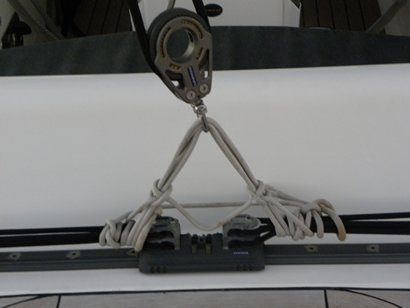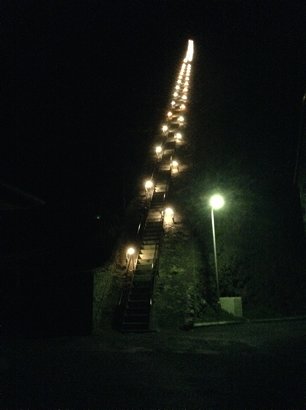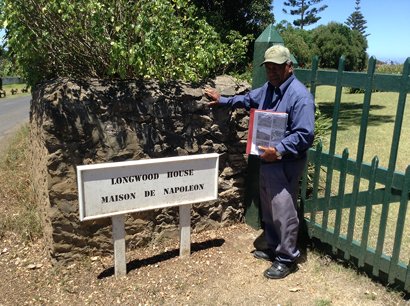15:55:457S 5:43:418W St Helena

Shaya Moya
Don & Susan Smyth
Thu 29 Jan 2015 15:28
|
The 1600nm from Cape Town to St Helena in the South
Atlantic Ocean has been the slowest yet. Light winds to no wind beset the voyage
and we motored a third of the distance, some 533nm. Our fuel consumption after
the service and repairs done in Cape Town has improved remarkably and we are
getting around 6-7 litres per hour. The fishing
has been very poor with only a couple of under sized tuna and nothing else. Even
the birdlife has been negligeable.
   With such light wind and the Ocean swell the boat
was rolling quite a bit. Even if one is used to it, the motion is uncomfortable.
We decided to gybe from port to starboard tack to try and get a better course to
St Helena on one such quiet day when things went pear shaped. As we loosened the
gybe preventer to swing the boom around, a larger than normal swell hit us,
rocking the boat side to side. The untethered boom swung from the one side all
the way to the other and with a shuddering crash, broke loose from the mainsheet
travellor. In laymen terms we lost control of the boom which swung across the
boat, breaking loose from where it is tethered to the block that controls it.
Disaster of course, but no new expearience for Shaya Moya. The same thing
happened to Reece and I on our leg from Tonga to New Zealand. We quickly used
the gybe preventer lines to secure the boom midships and then rigged a bridle to
hold the boom to the now broken car. Lesson learned.
   After 11,5 days we finally arrived at Jamestown, St
Helena's only town. The wharf has the rather quaint way of landing on the island
by hauling one self ashore using ropes hung from a derick. This is the only way
ashore, even from the occasional cruise liners and the mailship. Goods are
ferried via barge from the ship, anchored offshore , to the wharf where they are
lifted ashore by crane. We spent the three days there using the local ferry taxi
service for £1 per trip.
   The town itself is built in a narrow valley running
from the shore up to a dead end. When they ran out of space in the valley they
built on top of the southern hill. This is connected with the famous
Jacobs Ladder, some 699 steps. Yes Ted, Tom and I climbed it one evening. Ant
declined saying having climbed it once before 36 years ago he had the t-shirt. I
now know why.
   St Helena was on the route from Europe to the East
and prospered until the Suez canal was opened in 1869. Since then it has been
supported by the British who have governed the island for over 300 years. It has
a population of only 5500 people and is still struggling to be self supporting.
Cash crops like the wholesale planting of flax for making ropes was destroyed
with the invention of nylon.
  The Island is where Napolean was exiled
to in 1815, after being defeated in the battle of Waterloo. He died on the
island in 1821. We did an island tour and visited Longwood House that was built
for him, as well as his original tomb. He is no longer buried there. His body
was taken back to France in 1840. Another little known history of the island is
that the British held over 6000 Boer prisoner of war in a concentration camp on
the island.
Jamestown has a couple of supermarkets with limited
produce, imported mainly from South Africa. The RMS St Helena mailship brings
this to the island every 6 weeks. There is a lot of speculation on whether this
service will be reduced once the £400 million airport is completed. There are a
handful of restuarants.
  We visited one of the local pubs and met quite a
few characters. Ant was in his element showing his brochure of the island to the
locals and regailing them with his visit there in 1978. We met up with the
Editor and owner of the Independant newspaper, Mike Olsen and his wife Bernice,
a local Councillor who gave us an interesting insite to life on the island. It
seems that although dependant on the welfare from Britain, there is not a lot of
love for their Governship.
  A highlight of the stop here must be the wonderful
experience of snorkelling with a 10m whale shark. These docile plankton eating
mammals are inquisitive and he stayed near the surface for ages, allowing us the
opportunity of getting some amazing photos.
  All too soon, after three days on the island we
were on our way again to Salvador, Brazil, some 1900nm away across the Southern
Atlantic. The fleet has split up here, with some going to Ascension island and
then on to the Arc de Fernando de Noronho islands off the North East coast
of Brazil, missing the carnival in Salvador. We had contemplated doing something
similar as us oldies are somewhat past carnival age, however Joel from the ARC
team is kindly bringing the spare car with him to Salvador, much to young Tom's
delight.
|